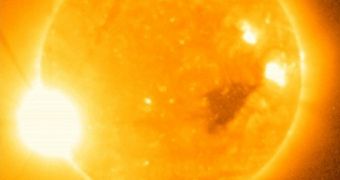Perhaps not many of you remember the agitation caused two years ago by a massive solar flare on December 5, 2006. It was an X9 event on a scale where an X1 is still considered very powerful, but X20 phenomena have been observed, fortunately scarcely enough. The one in 2006 was the most powerful in the last three decades, blasting with the force of a hundred million nuclear bombs, but surprisingly, this is not the most interesting part.
Such a blast, featuring temperatures 10 to 100 million degrees Celsius should normally leave nothing intact, still, the pair of NASA's Solar TErrestrial RElations Observatory (STEREO) spacecraft in orbit of the Sun (at different points) have recorded a 90 minute worth of intact neutral hydrogen atoms passing by, before the expected ions caused by the Shockwave. "No other elements were present, not even helium (the sun's second most abundant atomic species). Pure hydrogen streamed past the spacecraft for a full 90 minutes," shared Richard Mewaldt from Caltech, quoted by Universe Today.
So, although they could not have survived the explosion, the atoms were there, intact. The attempted theory states that they hadn't formed within the flare, but outside it, as its products reached interplanetary space. "We believe they began their journey to Earth in pieces, as protons and electrons," explained Mewaldt. "Before they escaped the sun’s atmosphere, however, some of the protons recaptured an electron, forming intact hydrogen atoms. The atoms left the sun in a fast, straight shot before they could be broken apart again."
These particles got to be ejected before they could be slowed down or deflected by the Sun's magnetic field, and this is the reason they managed to reach the STEREO spacecraft long before the ions did. The scientists plan to perform future similar observations during a powerful flare in order to understand whether this is a regular effect or whether it was just a one-time accident.

 14 DAY TRIAL //
14 DAY TRIAL //